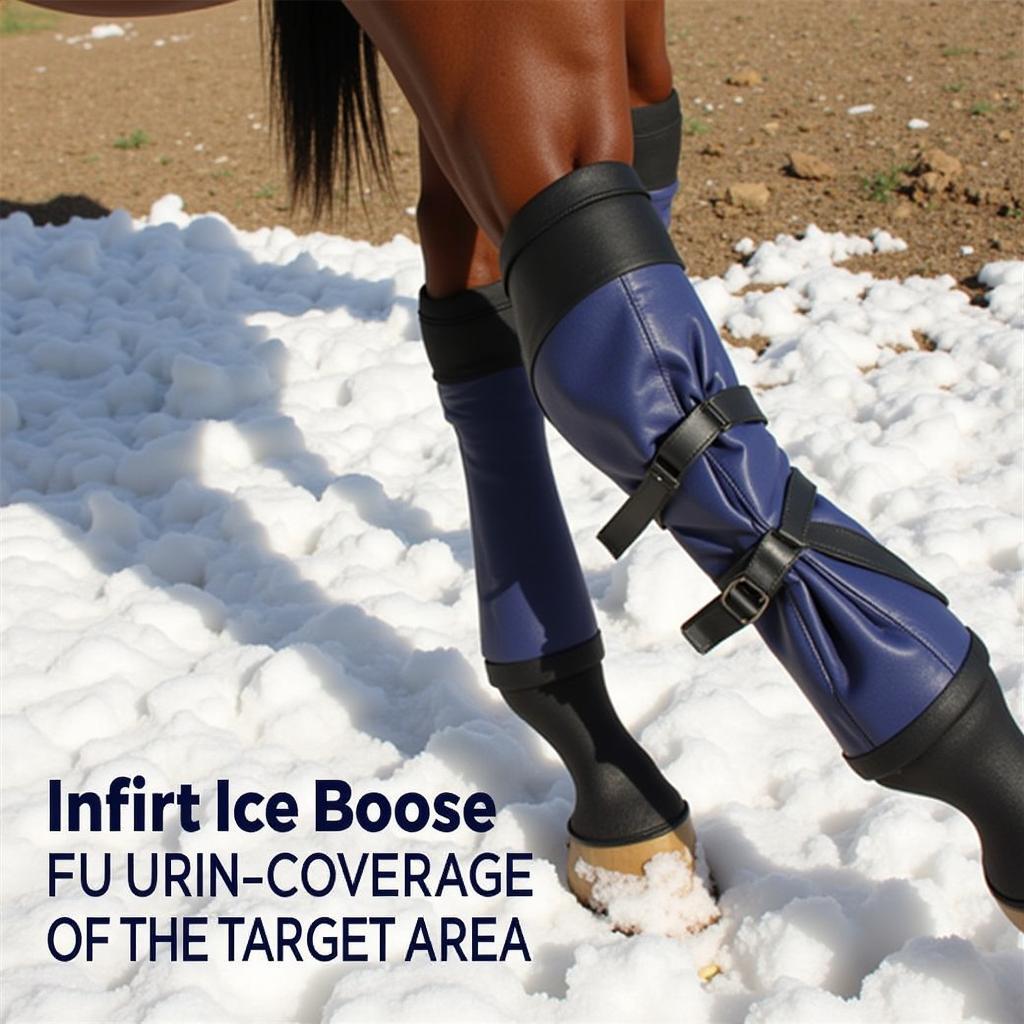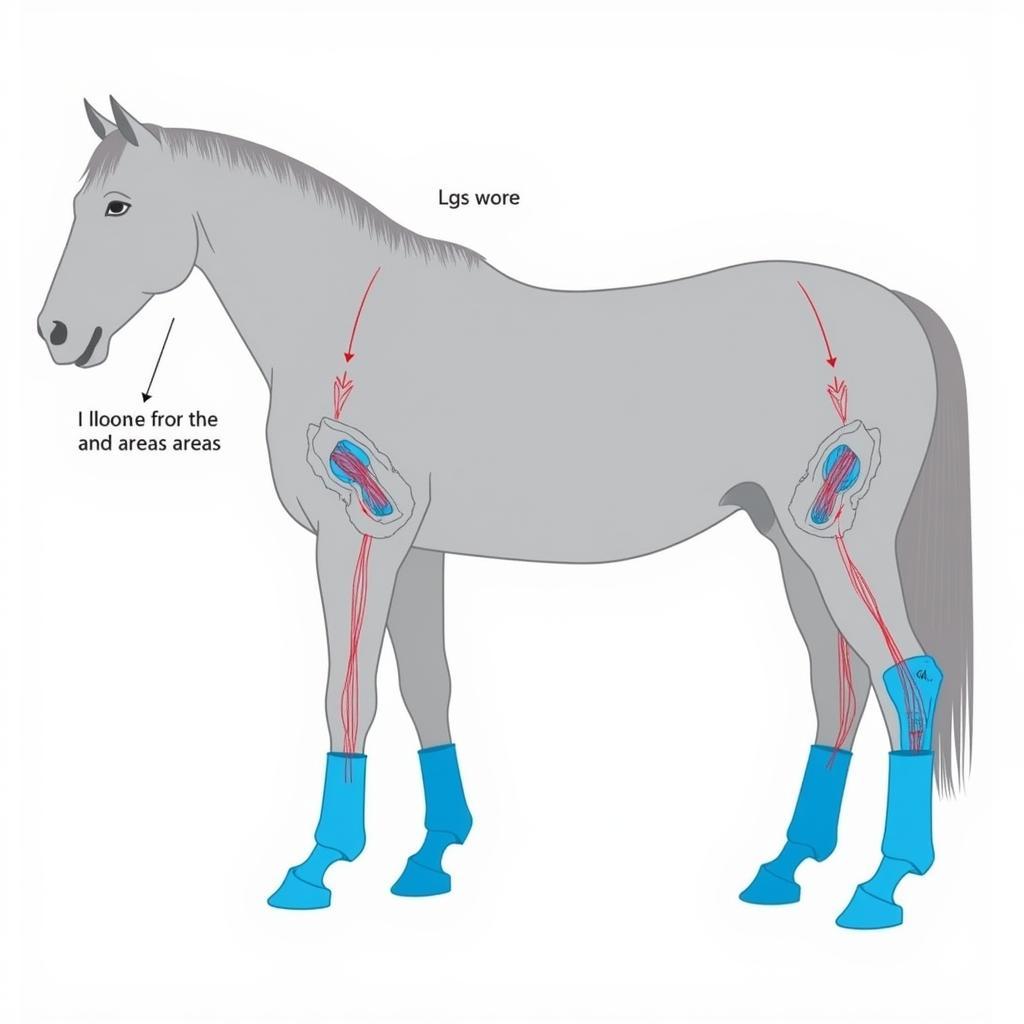Sound Horse Ice Boots are essential tools for any horse owner dedicated to providing optimal leg care for their equine companion. They play a crucial role in reducing inflammation and swelling after strenuous workouts or injuries, promoting faster healing and preventing long-term damage. Understanding how and when to use these therapeutic boots is key to maintaining your horse’s soundness and overall well-being.
Understanding the Benefits of Sound Horse Ice Boots
Ice therapy has long been recognized as a highly effective method for managing inflammation in both humans and animals. By constricting blood vessels, ice reduces blood flow to the affected area, minimizing swelling and pain. Sound horse ice boots take this principle a step further by providing consistent, targeted cold therapy to the horse’s legs, ensuring optimal therapeutic benefit.  Applying Sound Horse Ice Boots to a Horse's Leg
Applying Sound Horse Ice Boots to a Horse's Leg
Using sound horse ice boots can significantly shorten recovery time after intense training sessions, reducing the risk of soreness and stiffness. This allows the horse to return to work more quickly and comfortably. Furthermore, these boots are invaluable in treating a variety of leg injuries, from minor sprains to more serious conditions like tendonitis. By mitigating inflammation in the early stages of injury, sound horse ice boots can prevent further damage and promote healing.
Choosing the Right Sound Horse Ice Boots
With a variety of sound horse ice boots available on the market, selecting the appropriate type for your horse’s needs is essential. Consider factors such as the size and shape of your horse’s legs, the type of injury being treated, and the duration of icing required. Some boots are designed for specific areas like the fetlock or hoof, while others offer more comprehensive coverage of the entire lower leg. Remember the importance of the fetlock on a horse, as this is a common area for injury. padded horse shoes
Different cooling methods also exist, from traditional ice packs to more advanced gel packs or chemical-based cooling systems. Each method has its pros and cons, so weigh the benefits of each before making a decision. Gel packs, for instance, often provide a longer cooling duration than ice, while chemical packs offer portability and convenience.
How to Properly Use Sound Horse Ice Boots
Proper application of sound horse ice boots is crucial for achieving optimal results and avoiding potential harm. Always ensure the boots are clean and free of debris before applying them to your horse’s legs. The fetlock horse area requires particular attention. Use the appropriate size boot to ensure a snug yet comfortable fit. Overly tight boots can restrict circulation, while loose boots may not provide effective cooling.
When using ice packs, fill the boots with the recommended amount of ice and secure the closures firmly. For gel packs or chemical-based cooling systems, follow the manufacturer’s instructions for activation and application. Monitor your horse closely during the icing session and remove the boots immediately if any signs of discomfort or skin irritation appear.
When to Use Sound Horse Ice Boots
Sound horse ice boots are most effective when used immediately following strenuous exercise or injury. Applying ice within the first 24-48 hours can significantly reduce inflammation and minimize swelling. For routine post-workout cooling, 20-30 minutes of icing is typically sufficient. However, for more serious injuries, consult your veterinarian for guidance on the appropriate icing duration and frequency. It’s important to understand horse anatomy brain functions to fully appreciate the benefits of ice therapy. horse anatomy brain
Don’t overlook the importance of other aspects of horse care, like appropriate horse snow shoes during winter months. horse snow shoes
Why are sound horse ice boots important for post-workout recovery?
Sound horse ice boots are essential for post-workout recovery because they reduce inflammation and swelling in the horse’s legs, minimizing soreness and stiffness.
How long should I leave ice boots on my horse?
Typically, 20-30 minutes of icing is sufficient for routine post-workout cooling. Consult your vet for more serious injuries.
“Consistent use of sound horse ice boots is an investment in your horse’s long-term health and performance,” advises Dr. Emily Carter, DVM, specializing in equine sports medicine. “By incorporating ice therapy into your horse’s care routine, you can effectively manage inflammation, promote healing, and keep your horse feeling its best.”
 Horse Leg Anatomy and Ice Boot Placement
Horse Leg Anatomy and Ice Boot Placement
“Don’t underestimate the power of preventative care,” adds Dr. Carter. “Regular icing, even after light workouts, can help prevent minor injuries from becoming major problems.” fetlock on a horse
In conclusion, sound horse ice boots are invaluable tools for any horse owner. By understanding their benefits and proper application, you can significantly contribute to your horse’s well-being and performance. Incorporating this simple yet powerful therapy into your horse’s care routine is a crucial step in ensuring their long-term soundness and happiness.
FAQ
- What are the main benefits of using sound horse ice boots?
- How do I choose the right size ice boots for my horse?
- How often should I use ice boots on my horse?
- Can I leave ice boots on overnight?
- What are the different types of cooling methods available for ice boots?
- Are there any risks associated with using sound horse ice boots?
- How do I clean and maintain my sound horse ice boots?
For further reading, explore our articles on padded horse shoes.
If you need assistance, please contact us at Phone Number: 0772127271, Email: [email protected] or visit our address: QGM2+WX2, Vị Trung, Vị Thuỷ, Hậu Giang, Việt Nam. We have a 24/7 customer service team.